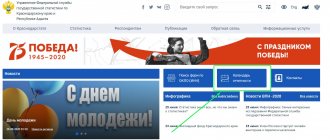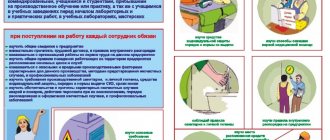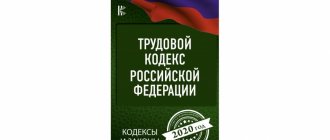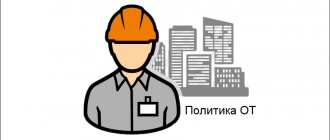Who is authorized to develop labor safety instructions?
According to Articles 212 and 225 of the Labor Code of the Russian Federation, responsibilities for ensuring labor protection and creating safe conditions at the enterprise rest solely with the employer. This means that it is the company that hires workers that is responsible for the timely conduct of scheduled and unscheduled briefings on labor protection, provision of all necessary personal and collective protective equipment, repair and replacement of workwear, organization of training in safe methods and techniques for performing the task, etc. .
Labor safety rules and regulations are also developed and approved by the employer, or more precisely, by an authorized employee or group of specialists. Since labor legislation does not contain precise instructions in this regard, the development of instructions can be entrusted to employees who are well versed in the peculiarities of specific labor functions - for example, heads of structural divisions of the company, who know first-hand what tasks, professional risks and problems their subordinates face.
The practice existing at some enterprises, which involves drawing up safety regulations for all positions by one employee (occupational safety specialist), can hardly be considered productive.
Firstly, this responsibility is not included in the list of labor functions of a labor protection specialist (which is confirmed by the relevant professional standard approved by order of the Ministry of Labor of Russia No. 524n dated 08/04/2014).
Secondly, for objective reasons, he is not able to demonstrate the same level of competence in each profession as heads of structural units with knowledge and experience in a particular field.
But an occupational safety specialist can and should provide methodological assistance in the development of documentation and training programs on occupational safety for workers. It is he who ultimately receives the finished draft document for approval (specialists from the HR or legal department can also take part in the development and approval of labor protection documentation). Make sure that the job descriptions or employment contracts of employees involved in the development of occupational safety documentation reflect these responsibilities.
DOWNLOAD FOR FREE SETS OF DOCUMENTS ON OCCUPATIONAL SAFETY
The set of documents includes:
Organizational policy in the field of labor protection
Provisions regulating the activities of the organization on labor protection
Orders on the appointment of responsible persons, on the introduction of regulations and others
Documents regulating the procedure for training in labor protection
Documents regulating the procedure for conducting labor safety briefings
Documents regulating the procedure for providing workers with personal protective equipment
Documents regulating the internship procedure
Documents regulating the procedure for conducting mandatory preliminary and periodic medical examinations of employees
Magazine forms
The documents are presented in the form of templates and are intended to assist in the formation of your own set of documents that forms the Occupational Safety and Health Management System (OSMS).
Service for developing a set of turnkey documents according to your staffing schedule - from 10,000 rubles.
FOR ESTABLISHING A CATERING ESTABLISHMENT
| Documents for a restaurant, cafe, canteen. |
FOR THE STORE
| Documents for the store. |
FOR HEALTHCARE INSTITUTIONS
| Documents for hospitals, clinics. |
FOR PHARMACY
| Documents for the pharmacy. |
FOR VETERINARY CLINIC
| Documents for a veterinary clinic. |
FOR WAREHOUSE
| Documents for the warehouse. |
FOR EDUCATIONAL INSTITUTION
| Documents for school, training center, institute, etc. |
FOR OFFICE
| Documents for the office. |
FOR OFFICE (ADVANCED)
| Documents for the office with workplaces for the driver and cleaner. |
Structure and content of labor protection instructions
When drawing up the Labor Safety Instructions, it is necessary to take into account the methodological recommendations that the Russian Ministry of Labor approved back in 2004. As a regulatory basis, you can use labor protection rules applied within a specific profession, position or industry, as well as standard intersectoral or sectoral instructions. For example, in the process of developing detailed safety regulations when performing the work duties of a forester, forester or assistant forester, it is recommended to take as a basis the “Standard instructions for the main professions and types of work in forestry”, approved by Rosleskhoz Order No. 213 of December 23, 1998.
For some areas of economic activity (including furniture production, consumer services, the construction industry and others), separate methodological recommendations for the development of documentation have been approved. If, during the development of the project, it turns out that neither methodological recommendations nor standard forms applicable to the profession or position in question exist, you will have to draw up a document “from scratch”, using all available sources of information:
- sanitary rules and regulations;
- technological documentation of a specific enterprise;
- operational and technical documents of manufacturers of equipment used in production;
- data on the actual working conditions of personnel.
The preparatory stage involves a careful study of technological processes, identification of harmful and dangerous factors in the production environment, identification of means and protective measures that can eliminate or reduce risks. All equipment used is tested for compliance with safety requirements. We study statistical data obtained from the analysis of labor protection documentation obtained at similar or similar enterprises in the same industry. If accidents have previously been recorded at work, you need to pull up the documents used to document them and analyze the causes of each incident.
The structure recommended by the legislator is based on five sections (general requirements, labor protection before starting work, during work and after its completion, as well as procedures in emergency situations). Each section is divided into paragraphs and subparagraphs - for example, reflecting safety requirements after completing a shift, you need to describe the correct procedure for turning off equipment, cleaning up production waste, processing workwear, etc.
In the section “Occupational Safety Requirements in Emergency Situations” it is recommended not only to provide a list of possible emergency and dangerous situations, but also to indicate the reasons that may cause them, as well as to describe in detail the action plan for workers in the event of an accident and the rules for providing first aid to victims with injuries or intoxication.
The section “General labor protection requirements”, as a rule, contains instructions on the need to comply with internal labor regulations and adhere to the work and rest regime established by the employer. Help
Section “General labor protection requirements”
- Lists of dangerous and harmful production factors that can have a negative impact on personnel;
- Lists of types of workwear and safety footwear issued to employees in accordance with existing standards and regulations;
- Lists of the types of personal protective equipment used (in addition to overalls) and disinfectants used when performing specific tasks.
It is necessary to inform personnel about the importance of observing personal hygiene rules for the safe performance of their work functions, as well as the procedure for notifying their immediate supervisor, technical specialist or management representative about injuries, accidents, malfunctions of equipment or tools.
The section “Occupational safety requirements during work” includes descriptions of methods and techniques for safely performing tasks (including the use of automated equipment, vehicles, lifting devices), instructions for preventing injuries and accidents, rules for the use of personal protective equipment, special clothing, flushing and disinfectants. The section “Occupational safety requirements before starting work” is devoted to preparing the workplace. Workers must know how to properly check the serviceability of equipment (alarms, ventilation, protective covers and interlocking devices, lighting devices, etc.) and the quality of raw materials before starting work, as well as how to safely take over and transfer shifts in enterprises with continuous technological process.
The employer has the right to add additional sections and annexes to the document with graphs, diagrams, and tables. The style of presentation should be concise, you should not use vague wording, as well as the words “strictly”, “categorically”, “mandatory” (it is understood that all requirements without exception are strictly fulfilled by the staff, so there is no need to specially highlight any points) .
All wording must be understandable to the employee, so phrases cannot be replaced with abbreviations without decoding. It is prohibited to add references to regulations: if the context requires it, part of a specific document (federal law, sanitary regulations, technological standards) is fully reproduced in the instructions so that the employee, after reading it, receives all the necessary information, and is not faced with the need to look for missing information in others sources.
The title page is drawn up in accordance with Appendix No. 1 to the “Recommendations”: the title must reflect the profession, position or type of task for which the document was developed (“for a gas welder”, “for a forwarding driver”, “personal computer maintenance”, “for work at height”, “during excavation work”, etc.).
Changes in labor protection legislation
| Legal act | Effective from | What changes have been made? | What does this mean, what to do |
| Decree of the Government of the Russian Federation of September 8, 2017 No. 1080 | 01.01.2018 | During inspections by the State Labor Inspectorate, checklists are now used for organizations whose occupational risks were classified as moderate. | Familiarize yourself with the classification of risks, as well as the GIT checklists. Even if there is no threat of a scheduled inspection this year, check that all labor safety documents are in order. |
| Order of the Ministry of Labor of the Russian Federation of July 28, 2021 No. 601N | 17.02.2018 | Labor safety rules for private security organizations and enterprises involved in the protection of facilities and property come into force. | Review local labor protection documentation and bring it into compliance with the new Rules. Conduct unscheduled training on labor safety in the workplace. Carry out the necessary labor protection measures in accordance with the new rules. |
| Order of Rostekhnadzor dated November 20, 2021 No. 486 | 18.03.2018 | Safety rules for underground gas storage facilities as hazardous production facilities are coming into effect. | |
| Decree of the Government of the Russian Federation of December 12, 2017 No. 1524 | 18.03.2018 | Drivers are now required to wear safety vests when stopping outside populated areas. | Reflect this requirement in the relevant labor protection instructions, convey new information to the organization’s drivers during unscheduled briefings at the workplace, as well as during special training on labor protection. |
| Order of the Ministry of Labor of the Russian Federation of November 23, 2021 No. 805N | 12.06.2018 | The employment contract should no longer contain standards for the distribution of cleaning agents, and the distribution of soap to employees who deal with easily washed-off contaminants need not be fixed. | Take into account the relaxation of requirements when concluding new employment contracts, without forgetting about the remaining requirements. For workers associated with easily flushable contaminants, abolish the maintenance of personal cards for recording flushing agents and reflect changes in the relevant OSH procedure. |
| Confused? Sign up for an express occupational safety audit! | |||
| Order of Rostechnadzor dated November 17, 2021 No. 485 | 23.06.2018 | Safety rules for hazardous gas, fire and repair work come into effect. | Review labor safety instructions when carrying out relevant work, conduct unscheduled briefings at the workplace, and, if necessary, retest knowledge of labor safety requirements. |
| Clauses 9 and 24 of the Standard “Providing workers with flushing and (or) neutralizing agents”, approved by Order of the Ministry of Health and Social Development of Russia dated December 17, 2010 No. 1122n | II quarter 2018 | Changes are being made to the flushing and neutralizing substances that are necessary to protect workers from chemical exposure. | Bring local labor protection orders that approve the standards for issuing flushing and neutralizing agents into compliance with the new requirements, and make changes to the relevant OSH procedures. |
| Appendices No. 1 and No. 4 to Order of the Ministry of Labor and Social Protection of the Russian Federation dated January 24, 2014 No. 33n | II quarter 2018 | The changes concern the procedure for action in the event that the results of the special labor assessment report do not reveal harmful/dangerous working conditions, as well as the rules for filling out section 3 of the special labor assessment report itself. | Before conducting the next special assessment of working conditions, carefully read the new requirements and ensure that the resulting documents are prepared correctly. |
| Order of the Ministry of Health and Social Development of the Russian Federation dated April 12, 2011 No. 302N | II quarter 2018 | The changes will affect the list of harmful and (or) dangerous production factors and work, during which mandatory preliminary and periodic medical examinations are carried out. | Review the lists of professions and positions whose employees are subject to preliminary and periodic medical examinations. |
| Resolution of the Ministry of Labor of Russia and the Ministry of Education of Russia dated January 13, 2003 No. 1/29 | II quarter 2018 | Now the period during which an employee must undergo compulsory labor protection training is increased to 5 years, and the connection to a specific organization is abolished. | Review and adjust the procedure for the occupational safety management system “Training of workers in occupational safety”, inform all relevant managers. |
| Occupational safety training (40 hours) - remotely! 2.5 t.r. Sign up | |||
Video on the topic: How to organize training for workers on labor protection and not go broke
General procedure for development and approval
First, the head of the organization issues an order, which instructs authorized employees to develop instructions (the positions and names of the performers responsible for the results and deadlines must be listed in the order). The list of documents to be developed is also reflected in the order or in the annex to it.
After completion, the project is submitted for approval to a full-time occupational safety specialist and other officials - in accordance with the procedure adopted in the organization. By the way, in order to avoid confusion during the approval process, it is recommended to establish a single algorithm for creating instructions in a local regulatory act. Then each employee involved in the process of their preparation and approval will clearly know their responsibilities and powers.
If the enterprise has an elected body of a primary trade union organization, the draft of each new instruction will first have to be agreed upon with it (Article 372 of the Labor Code of the Russian Federation obliges the employer in such cases to take into account the opinion of the trade union). The trade union representative, in turn, is obliged to give an official response on the project within five working days from the date of its receipt. The reasoned opinion of the body representing the interests of employees must be documented in writing. If he categorically disagrees with the contents of the document or proposes to improve it, the employer, in principle, can refuse all proposals, formalize the refusal in a protocol and approve the instructions, despite the protests of the trade union.
But in this case, the company is not immune from negative consequences: if the trade union appeals the employer’s decision in the State Labor Inspectorate or in court, the outcome of the proceedings could result in serious financial and reputational losses. Therefore, it is better not to enter into an open conflict, but to try to agree to the amendments proposed by the union or conduct additional consultations in order to find a compromise option that suits both parties equally.
After approval, the document is stitched and sealed with the seal of the organization, the pages are numbered, and a mark is placed on the title page stating that it has been agreed upon with the trade union and approved by order of the manager. The approval order must indicate the date on which the instruction comes into force and the details of the employees responsible for its reproduction, distribution and storage.
Validity period of labor safety instructions
The standard validity period of the document is five years (it is after the expiration of the five-year period that the Russian Ministry of Labor recommends revising the content of the Labor Safety Instructions). But this does not mean at all that changes will have to be made to them - if during the past period inter-industry and sectoral requirements for industrial safety have not been revised, and the working conditions of a particular enterprise have not changed, the validity period can be extended for another five years. To do this, the employer issues an order, the details of which are indicated on the title page of the relevant document along with the current date, date and signature of the official responsible for the revision.
However, in most cases, some adjustments still have to be made: progress does not stand still, production technologies change quite quickly, and workers face new tasks and professional risks. Sometimes, due to organizational or technological changes in the work process, instructions have to be revised ahead of schedule.
Reference
The need for early review arises in other cases:
- following a review of cross-industry or industry-specific safety standards and regulations;
- based on the results of the analysis of materials from the investigation of accidents and accidents at work;
- at the request of representatives of the State Tax Inspectorate and other regulatory authorities;
- based on the results of an investigation into cases of occupational diseases among company employees.
A special category is temporary Labor Safety Instructions, intended for workers of reconstructed and new production facilities being put into operation, and developed for a short period of time. As soon as the production is accepted into operation by the state acceptance commission, the validity period of the temporary labor protection documentation ends.
Storing labor safety instructions
Usually, the employer approves not just one copy of the labor safety rules, but an entire edition - from two or three to several dozen copies (depending on the size of the organization and the number of employees). All of them are registered in a special accounting journal, the form of which is also fixed in the “Recommendations” (Appendix No. 2). One copy is sent for storage to the Occupational Safety and Health Service, and the others are issued to the heads of the organization’s structural divisions or other officials, and the fact of issue must also be recorded in the journal, but in a different one (form in Appendix No. 3 to the “Recommendations”). If there is only one approved copy, you can issue copies to employees.
Do not underestimate the importance of the Labor Safety Instructions: they should always be “quickly available” to the employer, since they are presented to the State Labor Inspectorate inspector during inspection along with other mandatory documents - materials for workplace certification, logs of registration of introductory, initial, repeated and unscheduled briefings, log of inspections of legal entities and individual entrepreneurs.
Results
Standard instructions are developed by federal executive authorities.
They are the basis for approving instructions on labor protection for workers at a particular employer. An occupational safety specialist can provide methodological support and advice on the application of standard instructions. You can find more complete information on the topic in ConsultantPlus. Free trial access to the system for 2 days.







